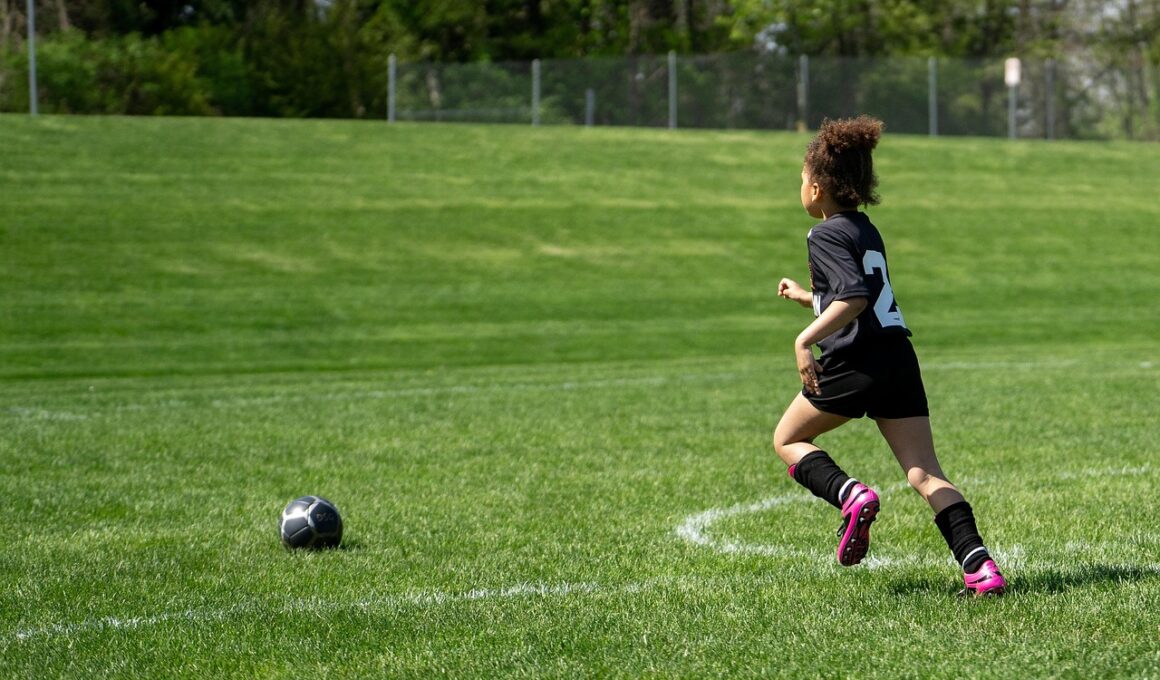Tracking Progress in Youth Aerobic Fitness: Tools and Tips
Engaging youth in aerobic activities is essential for promoting overall health and fitness. As children and teens develop, tracking their progress in aerobic fitness can help them stay motivated and reach their health goals. Utilizing various tools to monitor performance allows young individuals to be aware of their achievements, fueling their excitement for continued participation. One effective way to track progress is through the use of wearable fitness trackers, which can monitor heart rates and calories burned during activity. Parents and coaches can provide a supportive environment by discussing the data that these devices give and setting achievable goals. To ensure successful tracking, it is essential to set clear, measurable objectives. These can include duration of activities, frequency, or specific fitness benchmarks like completing a mile within a personal best time. Additionally, consider involving youth in the goal-setting process, as this encourages commitment. Keep track of accomplishments in a fun and engaging manner, such as through charts or fitness apps tailored for kids. This not only makes fitness enjoyable but also fosters a sense of ownership in their own health journey, ensuring youth find joy in aerobic fitness.
Setting Realistic Goals
When tracking progress in youth aerobic fitness, it’s crucial to set realistic and attainable goals. Kids and teens may have varying capacities for endurance, so their targets should reflect that. Using the SMART criteria for goal-setting can be particularly effective. Goals should be Specific, Measurable, Achievable, Relevant, and Time-bound, which ensures they are structured correctly. For example, rather than saying, “I want to run faster,” a more effective goal would be: “I want to run a mile in under ten minutes within eight weeks.” This specific goal gives young individuals clear direction and motivation. Measuring progress gives youngsters a sense of accomplishment as they work towards achieving their objectives. Additionally, it promotes a healthy mindset towards fitness, helping them understand that persistence is key. Regular check-ins can help assess performance and keep adjustments on track. Encouraging youth to share their experiences with friends or family creates a positive community around their fitness efforts. Focus on positive reinforcement, celebrating small victories along the way, and emphasize fun activities over competitiveness. The goal is to instill a lifelong appreciation for health and fitness, thereby establishing healthy habits early in life.
Another vital aspect of tracking aerobic fitness progress is regularly assessing physical capabilities. Utilizing fitness assessments can provide substantial insights into improvements or areas needing focus. Basic assessments might include time trials for running, performing jumping jacks for a certain duration, or aerobic capacity testing, such as the Beep Test. These evaluations help establish a baseline, making it easier to measure subsequent enhancements. Ensure that assessments are age-appropriate and conducted in a safe environment; this helps put youth at ease. Some may feel intimidated or anxious about testing, so a supportive approach is necessary. Include fun fitness challenges as part of assessments, ensuring that kids associate them with enjoyable experiences. Motivate participants to view results as exploration rather than competition, adjusting expectations according to each youth’s development stage. Combine quantitative data with qualitative measures, such as asking how they feel about their stamina or energy levels after activities. This holistic approach gives a more comprehensive view of their fitness journeys. Celebrate improvements, whether they are substantial or minor, reinforcing that progress is progress, and encouraging a continual love for aerobic activities that they can cherish for years to come.
Incorporating Technology for Tracking
With technology advancing rapidly, there are numerous apps and devices available that assist in tracking fitness progress. These digital tools enable youths to monitor their aerobic activities, set goals, and visualize their achievements over time with ease. Many applications available are designed to engage young users through gamification, which makes tracking fun and interactive. Popular fitness apps often allow users to log their workouts, providing visual charts and reminders that keep users motivated. Incorporating smartphones and wearable tech can inspire kids to set daily steps or exercise goals. One benefit of these technologies is the ability to share progress with peers, creating a community aspect that promotes healthy competition. Encourage friends to join fitness challenges, where they can cheer each other on. This fosters connection and accountability among peers. When utilizing technology, ensure that privacy settings are reviewed and maintained, as it’s crucial for parents to monitor the information shared online. Overall, integrating technology not only enhances engagement but also allows for an innovative approach to tracking youth fitness while educating them on the importance of staying active.
Parental involvement plays a significant role in encouraging youth to track their fitness progress. Parents can serve as positive role models by demonstrating healthy lifestyles and offering support in various activities. Being involved in aerobic exercises as a family can help motivate children, creating shared experiences and strengthening bonds. Regularly participate in family activities that get everyone moving, such as cycling trips, hiking, or fun runs. Discuss the importance of physical fitness openly and make it part of family conversations. In addition to participating, parents can guide children in using tools for tracking progress. Assist them in setting up fitness apps, using pedometers, or even keeping a record in a fitness journal. This makes tracking a fun family project that everyone can engage in together. Recognize the accomplishments of young athletes and emphasize growth over perfection. Celebrate achievements with rewards, which could be as simple as stickers, outings, or expanded privileges. Creating a supportive atmosphere negatively impacts youth performance but highlights the importance of health over competition. By fostering this environment, parents instill valuable lessons in resilience, teamwork, and personal fitness that will resonate throughout their children’s lives.
Creating a Fun Environment
A conducive environment for tracking progress greatly impacts the overall experience for youth engaging in aerobic activities. It’s critical to make workouts enjoyable and varied, catering to the interests and preferences of young individuals. Incorporating games, challenges, or themed activities can make fitness a fun pursuit. For instance, organize friendly competitions or relay races to foster enthusiasm among kids while helping them measure their abilities. Look for ways to incorporate music, colorful gear, and fun props into workouts to stimulate excitement. Establishing creative routines keeps the experience fresh and encourages more participation. Ensure that youth have some say in their activities to cultivate a sense of autonomy. This could involve activities they enjoy, like dancing, swimming, or group sports that they feel comfortable pursuing. By providing choices, children are more likely to feel invested in their fitness progress, leading to lasting engagement. Additionally, consider varying the environment where activities take place. Incorporate outdoor sessions to enjoy nature, mix up the locations, and let enthusiasm raise their interest levels. Ultimately, nurturing a vibrant atmosphere fosters a love for fitness and builds strong habits, paving the way for a lifetime of health.
As young individuals embark on their aerobic fitness journey, tracking their progress should not feel constraining. Rather, it should encourage curiosity and exploration within each youth. Regular reflection upon their journey allows them to assess how far they’ve come, understand the value of persistence, and recognize the necessary adjustments in their routine. Encourage kids to take ownership of their fitness by establishing personal benchmarks and self-reflection practices. For example, they can write down their feelings regarding aerobic activities in a journal, assessing their moods before and after participating. This can provide insights into how activities impact their physical and mental well-being. Reflective discussions with peers or family members after workouts can be immensely beneficial as well, allowing them to gain new perspectives. Highlighting the collaborative aspect of fitness nurtures social skills and teamwork and ensures every participant understands that progress occurs at their own pace. Encourage openness when discussing goals and ways to address setbacks. Ultimately, the objective remains the same: to inspire youth to continually engage in aerobic activities while empowering them to track and celebrate their progress responsibly.
In conclusion, tracking progress in youth aerobic fitness encompasses various tools and strategies to keep participants engaged and motivated. Utilizing wearable technology, setting realistic goals, and fostering parental involvement are essential components. Likewise, incorporating a fun environment and encouraging self-reflection ensures that youth enjoy their journey toward improved fitness. The combination of these elements creates a holistic approach that builds a positive fitness culture within families and communities. By focusing on the personal achievements of each individual rather than solely on competition, both youth and their families will foster a love for fitness and health. This approach cultivates physical and mental strength, ensuring youth develop lifelong habits of being active. Younger generations who adopt these practices also help create a healthier society overall, paving the way for future advancements. Educators and coaches can further enhance this process by continually supporting and reinforcing positive experiences in aerobic fitness. By emphasizing the importance of staying active and providing various opportunities for participation, we foster a healthier future. Tracking aerobic fitness progress becomes not only a journey within youth but a shared experience among families and communities through healthy living.


